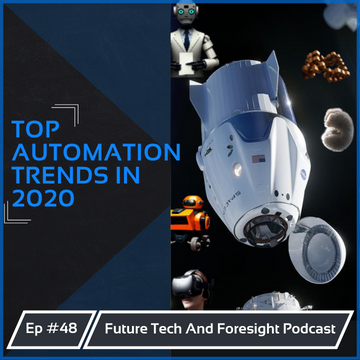About The Episode
Looking back at 2020 and what were the emerging technologies, trends, and events that had an impact into the world of automation?
The first episode of 2021! will take a look at events like GPT-3, Alphafold, Universal Basic Income schemes due to Covid-19, Xenobots, and more.
Transcript
- Xenobts
The first ever living robot was created in early January 2020. We’ve looked at industrial and service robots before, but what exactly is a living robot or Xenobot as it’s been called? They [Xenobots] are tiny, submillimetre-sized blobs for lack of a better word, containing between 500 and 1,000 cells that can so far move across a petri dish, and even carry very small payloads. They were designed by algorithms and constructed by humans using the stem cells from an African frog. The stem cells are manipulated into skin and heart muscle cells but for a more complex explanation of how this was done I’ve linked an article in the shownotes. The relevant part to know is that the generated skin cells act as a sort of mesh that holds everything together, while the contractions of the heart cell muscles propel the xenobots.
The machines moved around independently for up to a week powered by their own energy stores in the form of lipids and proteins. The researchers at the University of Vermont claim these are novel living machines and that they’re neither a traditional robot nor a known species of animal. It’s a new class of artifact: a living, programmable organism.” Apart from the pretty wild reality of this new technology, not to even mention ethical issues, I think the possibilities for using the ‘custom living machines’ will be what interests most of us. Some examples proposed are delivering medicine to specific areas or cleaning up microplastics from our oceans, and even scrape plaque from arteries.
- AI reporters
This year we saw one of the first clear cut cases of technological unemployment in the media industry when Microsoft replaced nearly 30 staff members who maintain the news homepages on Microsoft’s MSN website and its Edge browser with AI. This is part of a larger global trend away from humans in favour of automated updates for news. However this did not come without its share of issues. Only a month later, Microsoft’s AI mistook a band member of a mixed-race pop group in an article on racial issues just as the Black Lives Matter protests and riots were beginning in the USA, shedding further light on the possible problems of utilising AI agents as it pertains to marginalised groups. In episode #34, with Brigitte Tousignant we further discuss these and other ethical issues along with what is in store for the future of journalism as AI continues to creep into and disrupt the industry, if you want to hear more about this subject.
- GPT3-3
GPT-3 is the third generation of OpenAI’s general-purpose language algorithm that uses machine learning to generate amazing human-like text , answer questions and translate text on demand. It is made up of 175 billion parameters. 100 fold more parameters than GPT-2. For those of you that want a bit more of a technical breakdown of what GPT-3 is i’ll post a link in the shownotes which does a good job of that. But essentially it it has been trained on an archive of the internet called the Common Crawl, which contains nearly one trillion words of data
It works by analyzing a sequence of words, text or other data, then expanding on these examples to produce entirely original output in the form of an article or an image.
Significance
GPT-3 is the most powerful language model ever. GPT-3 is so good at what it does that it can deceive people on almost any topic it’s given, When properly primed by a human, it can write creative fiction; it can generate functioning code; it can compose thoughtful business memos or strategies; and much more.
human judges to guess which of a pair of articles was real and which was generated by GPT-3. Humans chose the real article only 52% of the time; in essence, humans were no better than a coin-flip at choosing the real article.
But, GPT-3 lacks the ability to reason abstractly; it lacks true common sense. When faced with concepts, content, or even phrasing that the Internet’s corpus of existing text has not prepared it for, it is at a loss. Perhaps said best by OpenAI CEO Sam Altman on Twitter: “The GPT-3 hype is way too much….AI is going to change the world, but GPT-3 is just a very early glimpse.” Nevertheless, it was a significant event that shows the potential power of AI integrating into our world.
- Deepmind’s Alphafold
Figuring out what shapes proteins fold into is known as the “protein folding problem”, and has stood as a grand challenge in biology for the past 50 years. In a major scientific advance, the latest version of our AI system AlphaFold has been recognised as a solution to this grand challenge by the organisers of the biennial Critical Assessment of protein Structure Prediction (CASP). This breakthrough demonstrates the impact AI can have on scientific discovery and its potential to dramatically accelerate progress in some of the most fundamental fields that explain and shape our world.
This has been a focus of intensive scientific research for many years, using a variety of experimental techniques to examine and determine protein structures. methods like cryo-electron microscopy, depend on extensive trial and error, which can take years of painstaking and laborious work per structure, and require the use of multi-million dollar specialised equipment.
A protein’s shape is closely linked with its function, and the ability to predict this structure unlocks a greater understanding of what it does and how it works. Many of the world’s greatest challenges, like developing treatments for diseases or finding enzymes that break down industrial waste, are fundamentally tied to proteins and the role they play.
I’ve talked about Alpha Go a number of times on the podcast, so it’s really interesting to see an offshoot from this AI system be used in a very different domain and be world class again, and I’m sure this won’t be the last.
- Autonomous space ship docking
Though the crewed SpaceX mission in April to the ISS had the capability to autonomously dock, it was still mostly done by the two astronauts on board. But, in early December, a SpaceX Dragon cargo ship arrived at the International Space Station to deliver supplies for NASA and docked itself without the help of astronauts. Though automated docking has occurred as far back as the late 60s with the Soviet Soyuz vehicle, the fact that SpaceX is a private company and also incorporates autonomous landings adds to the idea of a New Space Age dominated by commercial companies, but also highly incorporating automated systems to successfully achieve mission objectives.
- Autonomous trucks testing increased.
In 2020, one of the industry leaders in autonomous vehicles and Google’s original self-driving car project Waymo, received some 3 billion USD in investments outside of Google’s parent company Alphabet. Though the race for the first fully functional robotaxi service continues to receive much of the fanfare, autonomous long-haul trucking has received more attention lately. Waymo’s investment round coincided with a large scale self-driving truck experiment where 13 18-wheelers complete with cameras, lidar, and on-board computers are navigating Texas roads. Though it is unclear for how long these tests will take place, it can be argued that more and more focus is going towards the viability of long-distance autonomous trucking compared to robotaxis. But this is something that will be explored further this year on the podcast.
- Covid’s impact on autonomous delivery
This review wouldn’t be complete without looking at how Covid-19 has impacted technology and automation. Connected to the previous autonomous vehicle examples, is the increase in these technologies that have been used for delivery due to the pandemic. Most notably we have seen extensive use of drones as delivery bots during the lockdowns, reducing the risk to delivery personnel as a substantial increase in delivery demand occurred during this period. Though a number of urban and rural pilots were already in process before the crisis, these efforts were usually plagued with safety regulations and legislative barriers effectively not allowing any large scale implementations to occur outside of China. But, with the crisis a number of these barriers dissolved. The Federal Aviation Authority (FAA) in the US has noted that the lack of air traffic at present makes the use of drones relatively less risky, which is why it is granting drone flight waivers to help with the COVID-19 response. CAAs in the UK, India and Sri Lanka are also making it easier to deploy drones in response to the pandemic. In the UK, for example, the CAA is setting up ‘air corridors’ where drone flying rules are relaxed to deliver goods during coronavirus pandemic and beyond. Companies like Wing, Flytrex, and Zipline also increased their services during the lockdown to offer medicine, food, and household goods so it is quite likely that we will see the use of drones for delivery at a considerably accelerated pace as time goes on.
- Remote work and VR use
Perhaps most obviously has been the shift towards remote work for the vast majority of office workers around the globe. Connected to this has been the rise of Virtual Reality in serval work related fields, be it training, collaborate projects, or even conferences. Though unlike the other points in this list there wasn’t a singular event or example to represent this change, the conversations with VR experts that have happened on the podcast all coincide with the fact that VR usage has increased substantially over this past year. The turning point for me personally was going to a VR conference during the height of the quarantine in Spain and both watching the 3D models emerge in front of me during a presentation and networking with attendees from across the world in a beautiful open sky digital pavilion just beside San Francisco’s Golden Gate bridge. This experience really solidified the possibility of using VR in an ever greater remote and virtual world, and all of the podcast’s VR based guests have further supported this idea.
- Automation in Essential Industries
With social distancing in place and the need to restructure workplaces to minimize human contact, we have seen several examples of automation being accelerated across various sectors, especially in the essential services domains.
Numerous examples have been seen of robots being used in hospitals to either deliver supplies or even disinfect parts of hospitals to reduce the strain on the healthcare workers. In China there is a robot called Thor-1 that is remotely controlled and can disinfect a 10,000m^2 area in an hour. Many Chinese hospitals increased the deployment autonomous guided vehicles to deliver medicine, communicate with patients, and support nurses in various ways to reduce human contact. Drones that spray disinfectant from the sky and patrol public areas to notify officials of whether people are walking around without masks and violating other quarantine rules, were also used.
An example within the waste industry is AMP Robotics, which offers AI empowered robots to sift through recycled material to identify and weed out trash. The demand for their products significantly increased in the early days of the crisis, even in facilities that already had 1-2 robots installed. I’ll have an image of the different waste pieces being identified in the shownotes if you’re interested
- UBI
In several countries, UBI schemes or tests have been implemented over the last year due to economic stress brought on by the pandemic and the forced closure of businesses. Spain’s government has started what might be the world’s biggest economics UBI test. A programme will support 850,000 of the poorest households by offering monthly payments of up to €1,000 to the nation’s poorest families. And we have even seen stimulus cheques being handed out in the USA.
However, to date Finland is the only country that has managed to complete a nationwide randomized control trial of a basic-income program. Mckinsey consulting came out with a report which analyses the Finish study. I’ll link it in the shownotes if you want to read more about it, but overall in Finland’s two-year study, a treatment group of 2,000 randomly picked, initially unemployed people received a guaranteed, unconditional, automatic cash payment of a modest €560 per month instead of a basic unemployment allowance in similar amounts. The final results from the experiment show that the basic income in Finland led to a small increase in employment, significantly boosted multiple measures of the recipients’ well-being, and reinforced positive individual and societal feedback loops. It is also worth noting that the methods and conclusions of the Finnish study were not undisputed, but it is good to see yet another data point in this large and ever growing in importance topic.
Those were the main events and trends for 2020. It’ll be very interesting to see what kind of further developments happen due to the pandemic or otherwise in 2021 relating to automation, UBI, and emerging tech. Stay tuned for more.











